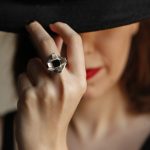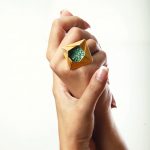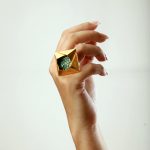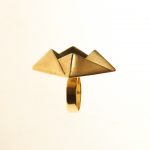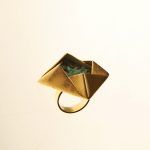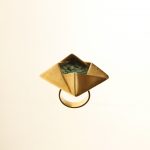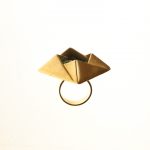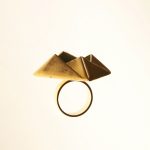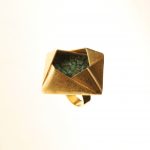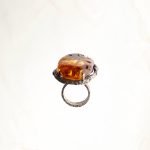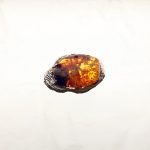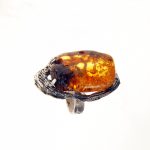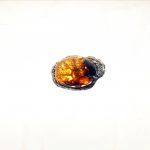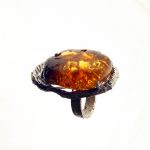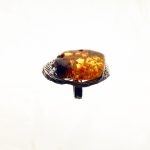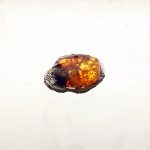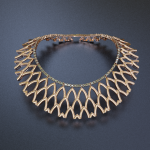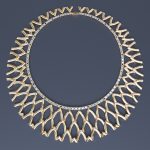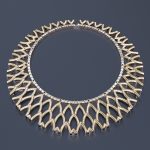
Golestan
This piece of jewelry is inspired by The Golestan Palace and traditional Iranian architecture. Old Iranian houses and palaces had two parts: Inside and outside. The Inside always had the best form of Iranian architecture, like the hall of mirrors in Golestan Palace. That’s why the inside of the piece has mirrors and enameling which are both important features of traditional Iranian art and architecture. The other side of the piece is using the other forms and motifs of Iranian architecture that exist in Golestan Palace and also features Neyshabur Turquoise stone.
Toranj
Persian Rug is one of Iran’s most important handcraft products and Persian rugs have been well known all around the world. One of the most famous cities in Iran for making handcrafted rugs is the city of Kerman. One of the characteristics of Persian rugs is the different types of flowers portrayed on the rugs, each with their own unique name. Also, every rug has different sections. “Toranj” is the middle of the rug and can have many different shapes. This ring takes inspiration from the design of Persian rugs and specially the “Toranj” section. Also uses the Red enamel that red color which is one of the most popular colors in Persian rugs. The chains that are hanging from the ring represent the carpet fringes. There are three different types flowers are connected to the fringes. While this ring takes inspiration from the most traditional Iranian arts, it still has a modern form to it.
Vilion Ring
The design of this ring is inspired by several different elements. The original idea of this piece of jewelry was formed from the Mirror Hall of Golestan Palace, which is based on geometric and broken forms. This art is also considered as one of the Iranian decorative arts. However, due to the weight of the mirror and also due to the presence of mercury in it, the mirror was not used in this ring, and instead of enamel, magenta and blue colors were used, which was also used in the tiles of the palace grounds. Enamel art is also one of the handicrafts of Iran. Another element was the overall shape of the diamond with the diamond cut, the ring shape is inspired by the pavilion. The base of the ring also has an almost triangular shape that matches the surface of the ring. Due to the existence of this form, the ring was named Vilion.
Corona19
While the world thought that another disease pandemic is not possible, in 2020 COVID-19 virus started to spread throughout the whole world and changed people’s lives. Scientists and hospitals had to work overtime to fight this virus and find a way to push it back but unfortunately the spread of the virus was too fast for most countries healthcare systems to handle. In results of that a lot of people lost their lives. But some countries put aside their political disagreements and worked together to fight the virus. So, in the design of this ring tries to represent the effects of the virus and the world, the changing of the sphere’s form is a symbol of the spread of the virus and the changing of people’s lives. The earth is represented with a simple sphere without the map of the world, because this virus spread around the world without caring about borders or race, showing that borders do not limit the disease and the countries had to work together to stop it. There’s a bandage all the way around the sphere, showing respect to healthcare workers from all around the world who were the true heroes in this pandemic. The names of the countries with the highest death rates ins written on the bandage. The base of the ring symbolizes the resistance of the world, standing against the virus, and the black stripe around the ring and inside the sunken area is to pay respects to those who lost their lives to the virus.
Museum Ring
This ring inspired by Tehran Museum of Contemporary Art’s building
designed. The building itself can be regarded as an example of
contemporary art with employing elements from Persian architecture.
The design of this ring has tried to display features inside and outside
the museum.
The voluminous portions are inspired by exterior architecture and the
centerpiece of the ring for which the Onyx gemstone is selected is a
symbol of a Japanese artist's oil pool (Noriyuki Haraguchi) inside the
museum.
The base of the ring is designed to induce a spiral walkway form of the
museum
Isfahan Ring
The design of this Ring was inspired by the Muqarnas patterns. In
Sheikh Lotfollah Mosque in Isfahan, Iran. This Mosque is located in
Nagshe Jahan Square in Isfahan and it’s of one Safavid Dynasty’s
(1501-1722) greatest achievements.
Muqarnas is a form of ornamented vaulting in Islamic architecture,
usually used on the ceiling of halls or doorways. The prominent
colors in Muqarnas are usually Turquoise blue, Azure Blue and
yellow.
The design of this ring tried to stay true to classic Iranian
architecture with the perfect Symmetry all around the piece. And the
empty place in the middle is representing the great pool in the middle
of Naghshe Jahan Square.
This Silver ring has golden plating because of the yellow color used
in Muqarnas patterns of the mosque. In the middle of the piece the art
of Firoozeh-Koobi is used. Which is one of Isfahan’s handicrafts in
which small pieces of Turquoise are used to make something. Basically
it’s the reusing of the remaining small pieces of Turquoise stone after
carving and shaping them. Also Turquoise blue is a very prominent
color in Mosques all over Iran and naturally it had to be used on this
piece.
Souvenir
This amber was brought to me from Russia as a souvenir, and I faded away from its beauty and detail, so I decided to design a ring that would show amber and be prominent and also remind me of the place where amber came from. Inspired by the locally designed tree trunk where amber is formed, the ring has a texture similar to that of a tree, and the amber circle resembles a hole in the trunk. In the process of construction, I tried to create many layers to symbolize the age of the tree and amber. I also put a glittering stone and amber glitter on the base. I think nature's beauty is perfect so it's the best source of inspiration. This ring is totally handmade.
Music Hall


















